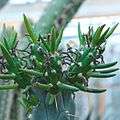Austrocylindropuntia subulata
Austrocylindropuntia subulata is a species of cactus native to the Peruvian Andes. The name subulata comes from the Latin subulate, for awl-like, referring to the shape of the rudimentary leaves.[3] It is also known by its common names as Eve's pin and Eve's needle.
| Austrocylindropuntia subulata | |
|---|---|
| Young plant | |
| Scientific classification | |
| Kingdom: | Plantae |
| Clade: | Tracheophytes |
| Clade: | Angiosperms |
| Clade: | Eudicots |
| Order: | Caryophyllales |
| Family: | Cactaceae |
| Genus: | Austrocylindropuntia |
| Species: | A. subulata |
| Binomial name | |
| Austrocylindropuntia subulata | |
| Synonyms[2] | |
| |
Description
Austrocylindropuntia subulata can reach heights up to 4 meters, with numerous branches. The elongated, slightly brittle branches are up to 50 centimeters long. The stems are marked by rhomboid to ovate bumps in a few spiral rows. At the tip of each bump is the areole, from which grow one to four straight, grayish-white spines up to 8 centimeters long. The awl-like rudimentary leaves are up to 12 centimeters long.
The red flowers are up to 6 centimeters long. The long, warty hypanthium is covered by rudimentary leaves up to 2 centimeters long. The fruit are ovoid or club-like and sometimes thorny. They are up to 10 centimeters long.
Distribution
Austrocylindropuntia subulata probably comes from the Peruvian Andes, where it is common at altitudes above 3000 meters. Today it has been naturalised in Argentina and Bolivia. It has been introduced in the Mediterranean basin to form impassable hedges, but it has become invasive in coastal provinces and some in the Iberian interior. It is also invasive in Australia, and it is illegal to be sold or distributed in the country under the Biosecurity Act 2015.[4]
Classification
The first description as Pereskia subulata took place in 1845 by Friedrich Mühlenpfordt.[5] Curt Backeberg classified it in the genus Austrocylindropuntia in 1942.[6]
References
- Cáceres, F. & Roque, J. (2013). "Austrocylindropuntia subulata". IUCN Red List of Threatened Species. 2013: e.T152809A681071. doi:10.2305/IUCN.UK.2013-1.RLTS.T152809A681071.en.
- "The Plant List: A Working List of All Plant Species".
- Urs Eggli, Leonard E. Newton: Etymological Dictionary of Succulent Plant Names. Springer, Berlin/Heidelberg 2010, ISBN 978-3-642-05597-3, S. 233.
- Austrocylindropuntia subulata (Eve’s needle cactus) Invasive Species Compendium by CABI
- F. Mühlenpfordt: Einige neue Cacteen. In: Allgemeine Gartenzeitung. Band 13, Nummer 44, 1845, S. 347 (online).
- Cactaceae. Jahrbücher der Deutschen Kakteen-Gesellschaft 1941. 1942, S. 12.






.jpg)
.jpg)